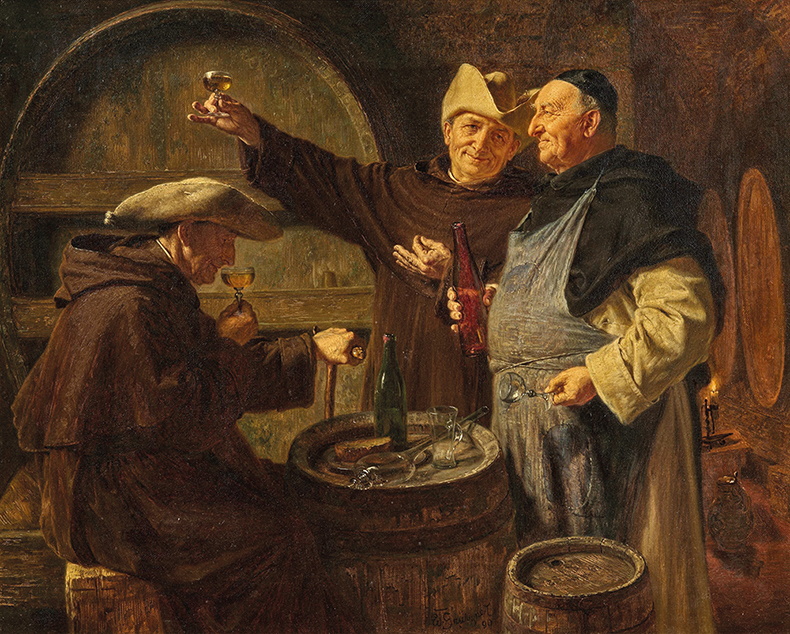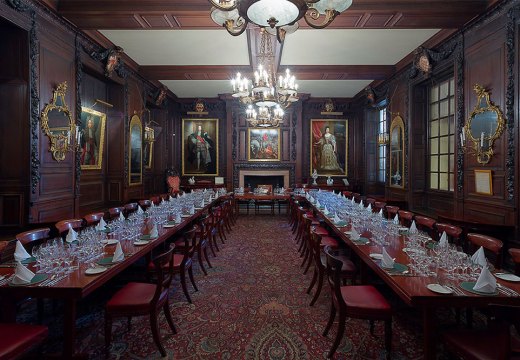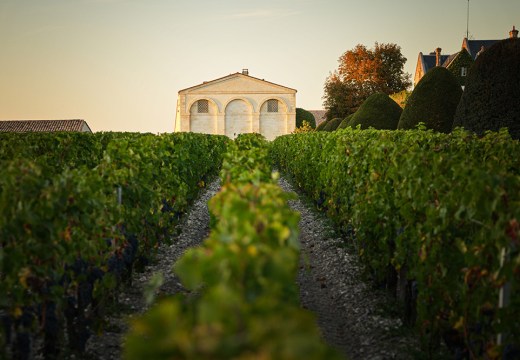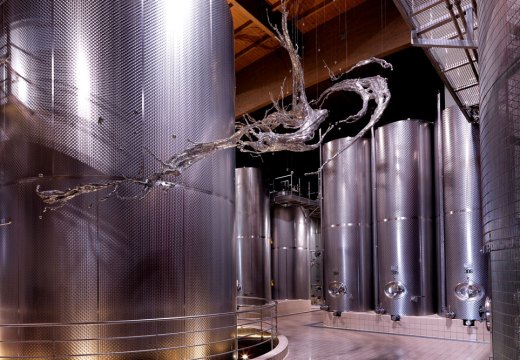From the April 2024 issue of Apollo. Preview and subscribe here.
In one picture, a rotund monk holds a glass of golden wine up to a crack of light in a cellar with a smile (Clear Wine); in another, A Good Vintage, a different monk poses with pride and glass; in yet another, a group of monks nod in agreement between them (Four Monks in a Cellar). These are all paintings by Eduard von Grützner (1846–1925), a German realist painter who specialised in cellared monks. He painted hundreds of subterranean abbots, mostly of a similar vintage and round build: unimpressed monks, reflective monks, wine-tasting monks, liquid-lunch monks, monks secretly knocking it back behind the barrel.
The wine cellar is an ancient invention: a Canaanite cellar at Tel Kabri in Israel dates back perhaps as far as 1900 BC. Other ancient civilisations, including Egypt and Rome, used cellars to store beer and wine, but the cellar as we understand it today – the sort of cellar that is the setting for von Grützner’s Falstaffian men of the cloth – developed in medieval times. Originally, monasteries dug ‘butteries’ to store food; wine was drunk to mark festivals and holidays, not stored for long periods of time. An ordinance of 1395 by Philip the Bold ushered in the dominance of the Pinot Noir grape in Burgundy, thereby creating the need for new winemaking methods and tools, including storage in cellars. No matter how fine the wine, without correct storage in dark spaces with regulated temperature, light and humidity, any expertise is wasted. So monasteries became wine producers and cellars began to resemble the ones we expect today.
The largest cellars in the world are at Milestii Mici in Moldova: they contain more than 2 million bottles and extend for 200km, of which 55km are in use; they can only be traversed by car. There are even underwater cellars: the Titanic sank 112 years ago with an estimated 1,000 bottles of what one presumes were the finest wines for its passengers – a few unopened bottles of champagne have been retrieved. The cellars of American wineries in particular seem to favour the other sort of spirits: part of Bartholomew Park Winery in Sonoma was once a morgue and Miles Wine Cellars in Finger Lakes, NY, is haunted by a number of spectres. Of course, these pale in comparison with the presence of Lucifer himself, who in 1883 reputedly paid a visit to the cavernous cellars of the Concha y Toro winery in Chile to keep workers in line (and presumably help with sulphur preservatives). Suddenly, the resident spiders of Château Musar’s cellars seem rather cute.

A Good Vintage (1890), Eduard von Grützner. Private collection. Photo: akg/van Ham/Sasha Fuis, Cologne
When the pirate Captain John Howard Graysmith built his grand mansion in Nassau in 1780, he dug into the rock to store his plunders. In 1844 the house became the Graycliff Hotel, the first hotel in the Bahamas; during the American Civil War, when Confederate blockade-runners were stop ping in Nassau, the cellars became a prison. The hotelier Enrico Garzaroli purchased the Graycliff in 1973 to store his collection of more than 75,000 bottles from 500 producers and 18 countries, documented in its 121-page tome of a wine list. It was once the world’s most expensive collection, valued at over $25m. Stumbling about its labyrinth, one finds bottles stored in every nook and cranny, making it a shabby jumble of oenophilia. It also displays the oldest drinkable wine in the world, the priceless 1727 Bremer Ratskeller Rüdesheimer Apostelwein.
In London, the commuters rushing in and out of Green Park tube station every day are probably unaware that running adjacent to the tunnels are the Stafford Hotel’s 380-year-old cellars. The space has its own share of history: built in the 17th century by Lord Francis Godolphin, it reputedly has a doorway leading to St James’s Palace. Lady Lyttelton, a nanny to Queen Victoria’s children, lived in what was still a private house and expanded the cellars. She was not the last woman to make her presence felt here. During the Second World War. Madame Prunier, whose restaurant, Maison Prunier, was nearby on St James’s Street, took over the cellars to house her own wines and added a door to accept deliveries of claret arriving from France for the royal palaces. During the Blitz, the wine cellars were also used as air-raid shelters and provided housing for American GIs. The Stafford’s present collection of over 8,000 bottles is one of the most complete in terms of fine wine types – almost a museum of notable wines.
According to the French philosopher Gaston Bachelard, the cellar ‘is first and foremost the dark entity of the house, the one that partakes of subterranean forces. When we dream there, we are in harmony with the irrationality of the depths.’ The cellar used for wine is insulated from these symbolically sinister associations because it protects the past winemaking endeavours and artistry yet also offers potential for future enjoyment. Perhaps that is why the satisfied monks are always smiling in von Grützner’s paintings.
From the April 2024 issue of Apollo. Preview and subscribe here.
Unlimited access from just $16 every 3 months
Subscribe to get unlimited and exclusive access to the top art stories, interviews and exhibition reviews.














![Masterpiece [Re]discovery 2022. Photo: Ben Fisher Photography, courtesy of Masterpiece London](http://www.apollo-magazine.com/wp-content/uploads/2022/07/MPL2022_4263.jpg)
It’s time for the government of London to return to its rightful home